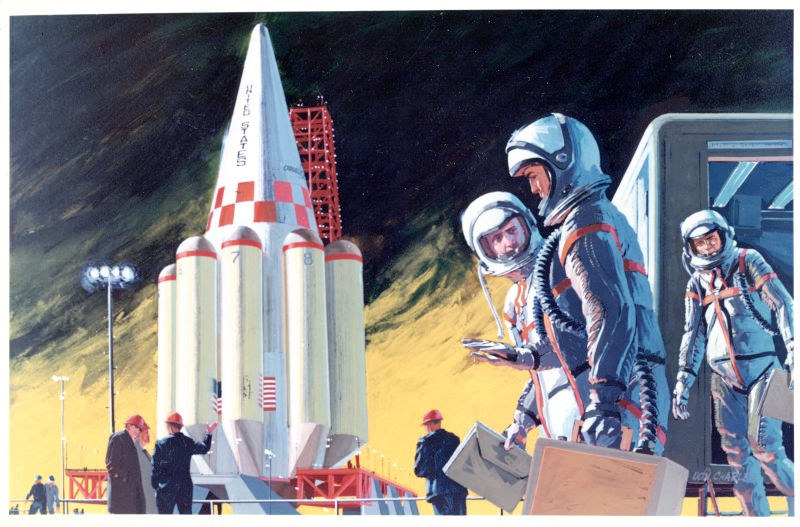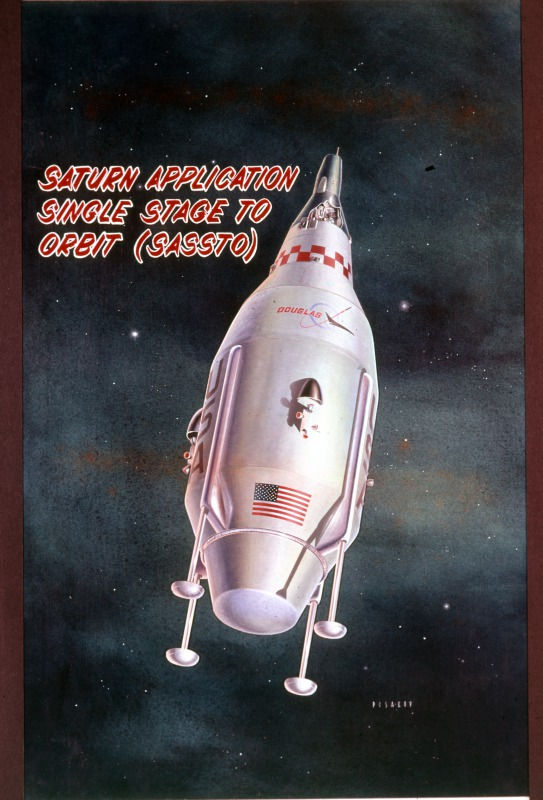One Giant Leap: Philip Bono's ROMBUS
- Aeryn Avilla
- Oct 28, 2021
- 6 min read
Updated: Mar 20
Philip Bono was a renowned space engineer whose designs paved the way for single-stage-to-orbit (SSTO) and vertical takeoff and landing (VTOL) spacecraft such as McDonnell Douglas's DC-X and SpaceX's Starship. His innovative concepts ranged from suborbital passenger transports to expeditions to the moon and Mars.

Bono was born in Brooklyn, New York on January 13, 1921. After serving in the US Navy Reserves during World War II, he first worked as an engineer for North American Aviation from 1947 to 1949. From 1949 to 1951, he worked for Douglas Aircraft Company before being employed by Boeing, where he remained until 1960. Afterwards, he was hired away by Douglas Huntington Beach and it was during this period he did the majority of his advanced space design work [1]. Among his early designs is Nova, the super heavy-lift launch vehicle and competitor to the Saturn V. Bono's first design for a reusable SSTO booster was named ROOST, standing for Reusable One-stage Orbital Space Truck. ROOST developed into ROMBUS, which is the focus of this post. Bono obtained two patents in 1965 and 1967 for a recoverable single stage spacecraft booster and in 1969 co-authored the book Frontiers of Space, which is available for purchase online. Mere months after his death on May 23, 1993, his old employer McDonnell Douglas flew the first of a series of successful DC-X test flights.
The Reusable Orbital Module-Booster & Utility Shuttle (ROMBUS) was an SSTO VTOL heavy-lift recoverable launch vehicle that was designed and proposed in 1964. It was pitched as a low-cost follow-on to the Apollo Program. The vehicle was centered around Bono's patented plug nozzle rocket engine, which doubled as a heat shield. The liquid hydrogen used for fuel was first used to cool the aft end of the rocket near the engine before being burned. During ascent, the nozzle also provided automatic altitude compensation for good performance not only when at sea-level atmospheric pressure but also in space [2]. ROMBUS had thirty-six engines and stood 95 feet (29 m) tall with a diameter of 78 feet (24 m) and a payload capacity of 990,000 pounds (450,000 kg) to low Earth orbit [3]. Although it consisted of only one stage, it dropped eight empty liquid hydrogen tanks during ascent. The tanks were an effort to reduce the cost and size of the booster and they would have returned to Earth under parachute recovered at sea like the solid rocket boosters of the Space Shuttle.
ROMBUS would have launched from the Kennedy Space Center in Florida and used the same construction and processing facilities as the Saturn V rockets but a new launch pad. Orbital insertion would be achieved by sixteen of the thirty-six engines firing for three seconds once in the thermosphere. The vehicle would spend twenty-four hours in orbit before de-orbiting and returning to its launch site. The final touchdown burn would be performed by only four engines operating at 25% thrust for twelve seconds. The total cost of ROMBUS in 1964 dollars was $10 billion over ten years plus another $4 billion for the development portion of the project. A single launch would cost $25 million as compared to the $185 million each Saturn V launch costed. ROMBUS was also featured in the "Flight to the Moon" attraction at Disneyland in California in 1967.

Ithacus was an adaptation of ROMBUS as an intercontinental military troop transport and aimed to reduce the need for overseas bases. It would have been somewhat taller than the original ROMBUS but would have operated essentially the same way. There were two iterations of this concept: Ithacus Senior and Ithacus Junior. Ithacus Senior. had a height of 209 feet (64 m) and a diameter of 78 feet (24 m). Due to its size, one of the primary concerns was returning it back to the launch site. It could not self-ferry because it would have produced liftoff thrust way too high to not need a heavy-lift capable launch pad— a new pad would need to be built wherever Ithacus was meant to touch down. Instead, Douglas Aircraft settled for shorter "hops" of a few hundred kilometers at a time.It also would have been transported by a Saturn V-type crawler transport onto a barge for return to the United States. The smaller Ithacus Jr. would have been able to transport 260 soldier or 33.5 tons of cargo overseas in one launch. It was proposed that two would launch at a time— one carrying cargo and the other carrying crew— from the decks of Enterprise-class nuclear aircraft carrier. These ships were chosen because they could use the power from their nuclear reactors to produce liquid hydrogen and liquid oxygen for seawater using the process of electrolysis. The boosters would be stored inside hangars prior to launch and would land approximately 600 meters apart.


The Saturn Application Single Stage to Orbit (SASSTO) was an SSTO VTOL launch vehicle studied from 1966 to 1967. It was essentially a modified Saturn S-IVB stage with the same plug nozzle engine as ROMBUS. It would have had a height of 68 feet (21 m) and a diameter of 22 feet (6.7 m), as well as a payload capacity of 8,000 pounds (3, 629 kg) to an altitude of 1,152 miles (1,855 km). SASSTO was the result of a Douglas study into VTOL vehicles incorporating an aerospike engine [2], ballistic reentry, and an actively cooled heat shield. The biggest modifications to the S-IVB, other than the ROMBUS plug nozzle engine and its cooling system, were an aft-mounted liquid hydrogen tank to minimize the difference between the vehicle's center of gravity and its center of aerodynamic pressure and ablative material bonded to the aluminum outside for heat protection. After launching from the Kennedy Space Center and completing two or three orbits, the SASSTO would land in either El Paso, Texas, or at the Wendover Range in Utah. Wendover was the preferred emergency landing site since the vehicle could have been returned to Florida inside an Aero Spacelines Pregnant Guppy aircraft from the nearby Hill Air Force Base. The booster's standard payload, as shown in the illustration, would have been a two-man Gemini spacecraft. During launch, it would have been protected by a jettisonable fairing to reduce drag and serve as an emergency escape system [4]. Douglas Aircraft also wanted the SASSTO to be capable of satellite inspection missions and potential space station resupply flights with durations of two days. The company also pitched their vehicle as a more-capable upper stage to be used with the Saturn IB or Saturn V. SASSTO would have cost $1.1 billion in 1966 dollars.
NASA did not pursue SSTO VTOL vehicles until the 1990's with Lockheed Martin's VentureStar and DC-X, although some might argue the first VTOL spacecraft in history was the Apollo Lunar Module. Unlike VentureStar, the DC-X flew a number of missions from 1993 to 1996 and is the first rocket to have landed on Earth (not crash into). Now thanks to private enterprise, Bono's concepts are coming to life, most evidently with SpaceX's Super Heavy booster and Starship. Whether you love him or hate him, Elon Musk's company has proven the reliability of reusable boosters and VTOL. In fact, the crew of US Crew Vehicle-1 became the first people to fly on a reused rocket in late 2020. 60 years later, Philip Bono's dreams are becoming reality and will one day, more than likely, be responsible for sending the first humans to Mars.

Author's note: I'm hoping to write another post about Bono's concepts if this post is well-received. Spoiler alert; it'll be about Project Selena, Pegasus, and possibly one more. As always, thanks for reading and be sure to like, comment, and share!
[1] Now part of Boeing as a result of McDonnell Douglas's merger with Boeing in 1997.
[2] An engine that maintains aerodynamic efficiency across a wide range of altitudes is known as an aerospike engine.
[3] A launch vehicle with that payload capacity is known as a Nova-class booster, named after the Nova family of heavy-lift rockets.
[4] The Gemini-Titan Launch Vehicle had no launch escape system.
Bibliography
Petty, Chris B. “Straight Back down to Earth: A History of the Vertical Takeoff/Vertical Landing Rocket – Part 1.” The High Frontier, 3 May 2018, https://thehighfrontier.blog/2016/03/20/straight-back-down-to-earth-a-history-of-the-vertical-takeoffvertical-landing-rocket-part-1/.
“Philip Bono Personal Papers.” San Diego Air & Space Museum, https://sandiegoairandspace.org/collection/item/philip-bono-personal-papers.
Wade, Mark. “Bono, Philip.” Encyclopedia Astronautica, http://www.astronautix.com/b/bono.html.



Comments